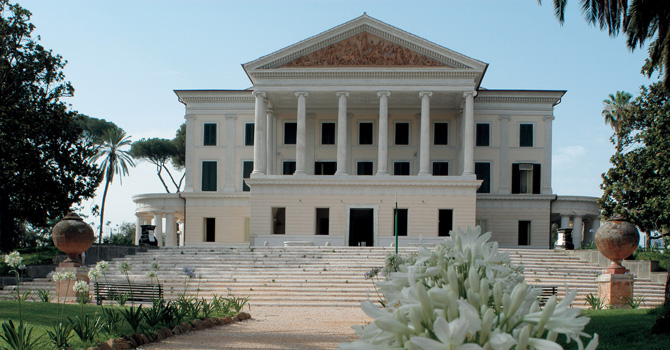Casino Nobile or Palace
In 1796 Giovanni Torlonia purchased the Vigna Colonna, situated on the Via Nomentana, and commissioned Giuseppe Valadier to render the buildings and park more imposing.
Between 1802 and 1806 Valadier worked on the rebuilding and enlargement of the Casino Nobile, incorporating the old structure and adding to it with foreparts, porticoes and spacious terraces.

The core of Valadier’s version of the palace was the Salle à manger (Dining room), which is today known as the Ballroom. Illuminated by a single large semicircular window, the light was reflected by the mirrors that lined the other walls, artificially increasing the sources of light and creating the illusion of a large space.
The salon was decorated with elegant stucco hangings, paintings by Domenico Del Frate, and ten plaster low reliefs by Antonio Canova (some of which are today displayed in the “Bercerau” Room).
After Giovanni’s death, in 1832 his son Alessandro commissioned the painter and architect Giovan Battista Caretti to add further to the majesty and magnificence of the palace, and to decorate it with works by various talented artists and craftsmen.
To make the Palace more visible to those arriving from outside the city, the original simple facade designed and built by Valadier, which faced onto Via Nomentana, was given a grandiose pronaos. This, in turn, was endowed with a monumental loggia closed by a triangular pediment that enclosed a terracotta high relief of Bacchus returning triumphant from the Indies on a chariot drawn by tigers by Rinaldo Rinaldi.
The two small porticoed wings designed by Valadier were replaced by two porticoes with Doric columns that encircled the east and west sides of the Palace, forming semicircular projections at the four corners.
The severe and imposing monumental aspect of the building was acceded to by a wide steps leading up the Capitoline (Cordonata) that was at one time lined with colossal ancient statues.
But Caretti’s most extensive renovation was to the internal decorations which, more than the architecture, gave a completely new definition to the spatiality of the rooms.
The ground floor and piano nobile were used for official purposes, and their rooms were decorated throughout in varying styles and motifs that were perfectly in keeping with the referential taste that characterised the villa as a whole.
The service rooms and lodgings for the servants occupied the second floor and basement, and from the latter an underground gallery (still existing) led to the Casino dei Principi.
The basement also provided access to two bunkers built by Mussolini – one as a bomb shelter and the other as a gas shelter (temporarily closed to the public) and to an underground room discovered during recent restoration work.
This was built by Giovan Battista Caretti to resemble an Etruscan Tomb in both its construction and decorations, which were clearly inspired by the images found on Etruscan-Corinthian earthenware.












































